menu
quickconnect
quickconnect
quickconnect
quickconnect
Quickconnect - an efficient way to create virtual connections - Casestudy | Equinix
Quickconnect - an efficient way to create virtual connections - Casestudy | Equinix
Quickconnect - an efficient way to create virtual connections - Casestudy | Equinix
Quickconnect - an efficient way to create virtual connections - Casestudy | Equinix
00

00

00

00

problem
Cloud Solution Architects can create virtual connections with Cloud Service Providers (Google Cloud) to their ports however, current process creates a fragmented experience by requiring users to hop between Fabric and Cloud service providers portals multiple times. If the user wants to create a pair connection (redundant) they need to go through the process twice, which can be time consuming.
solution
Quick connect feature helps Cloud solution architects to instantly create redundant connection with their assets (ports, gateways) to cloud service providers network all inside Fabric. We solved this by introducing Cloud Service Providers Sign in authentication step that allows Fabric to create redundant connection on behalf of users and automate the additional steps which required users to leave the Fabric portal. Resulting in a seamless and intuitive experience.
problem
Cloud Solution Architects can create virtual connections with Cloud Service Providers (Google Cloud) to their ports however, current process creates a fragmented experience by requiring users to hop between Fabric and Cloud service providers portals multiple times. If the user wants to create a pair connection (redundant) they need to go through the process twice, which can be time consuming.
solution
Quick connect feature helps Cloud solution architects to instantly create redundant connection with their assets (ports, gateways) to cloud service providers network all inside Fabric. We solved this by introducing Cloud Service Providers Sign in authentication step that allows Fabric to create redundant connection on behalf of users and automate the additional steps which required users to leave the Fabric portal. Resulting in a seamless and intuitive experience.
problem
Cloud Solution Architects can create virtual connections with Cloud Service Providers (Google Cloud) to their ports however, current process creates a fragmented experience by requiring users to hop between Fabric and Cloud service providers portals multiple times. If the user wants to create a pair connection (redundant) they need to go through the process twice, which can be time consuming.
solution
Quick connect feature helps Cloud solution architects to instantly create redundant connection with their assets (ports, gateways) to cloud service providers network all inside Fabric. We solved this by introducing Cloud Service Providers Sign in authentication step that allows Fabric to create redundant connection on behalf of users and automate the additional steps which required users to leave the Fabric portal. Resulting in a seamless and intuitive experience.
problem
Cloud Solution Architects can create virtual connections with Cloud Service Providers (Google Cloud) to their ports however, current process creates a fragmented experience by requiring users to hop between Fabric and Cloud service providers portals multiple times. If the user wants to create a pair connection (redundant) they need to go through the process twice, which can be time consuming.
solution
Quick connect feature helps Cloud solution architects to instantly create redundant connection with their assets (ports, gateways) to cloud service providers network all inside Fabric. We solved this by introducing Cloud Service Providers Sign in authentication step that allows Fabric to create redundant connection on behalf of users and automate the additional steps which required users to leave the Fabric portal. Resulting in a seamless and intuitive experience.
year
2021
year
2021
year
2021
year
2021
timeframe
6 Months
timeframe
6 Months
timeframe
6 Months
timeframe
6 Months
tools
Figma, Miro
tools
Figma, Miro
tools
Figma, Miro
tools
Figma, Miro
category
UI/UX
category
UI/UX
category
UI/UX
category
UI/UX
about the project
In the QuickConnect project at Fabric, my role as a UX designer was pivotal in transforming how Cloud Solution Architects interact with Cloud Service Providers like Google Cloud. I identified critical inefficiencies in the existing process for creating virtual connections, which was cumbersome and time-consuming, especially when establishing redundant connections. To address these challenges, I spearheaded user research, conducting interviews with internal architects to unearth pain points and synthesized these insights into user journey maps for three major Cloud service providers. My contributions included designing interactive Figma prototypes to visualize solutions, collaborating closely with Technical Product Managers and Architects to refine these designs, and implementing Analytics Metrics in Amplitude to monitor user interactions and inform future design enhancements. The culmination of this effort was the integration of a Cloud Service Providers Sign-in authentication step, enabling a more streamlined and automated connection process within the Fabric portal, significantly enhancing user experience and efficiency.
about the company
Equinix is the world’s most expansive, secure and sustainable data center platform which specializes in internet connection and digital interconnection related services. They own and operate a network of 220+ data centers in 44 major metropolitan areas and 22 countries on five continents.
problem identification
The current process for establishing connections with Cloud Service Providers is fraught with inefficiencies that compromise user experience. Key issues include:
1. Multiportal Process: Users must navigate between multiple portals, generating and using connection keys in a fragmented sequence that disrupts workflow.
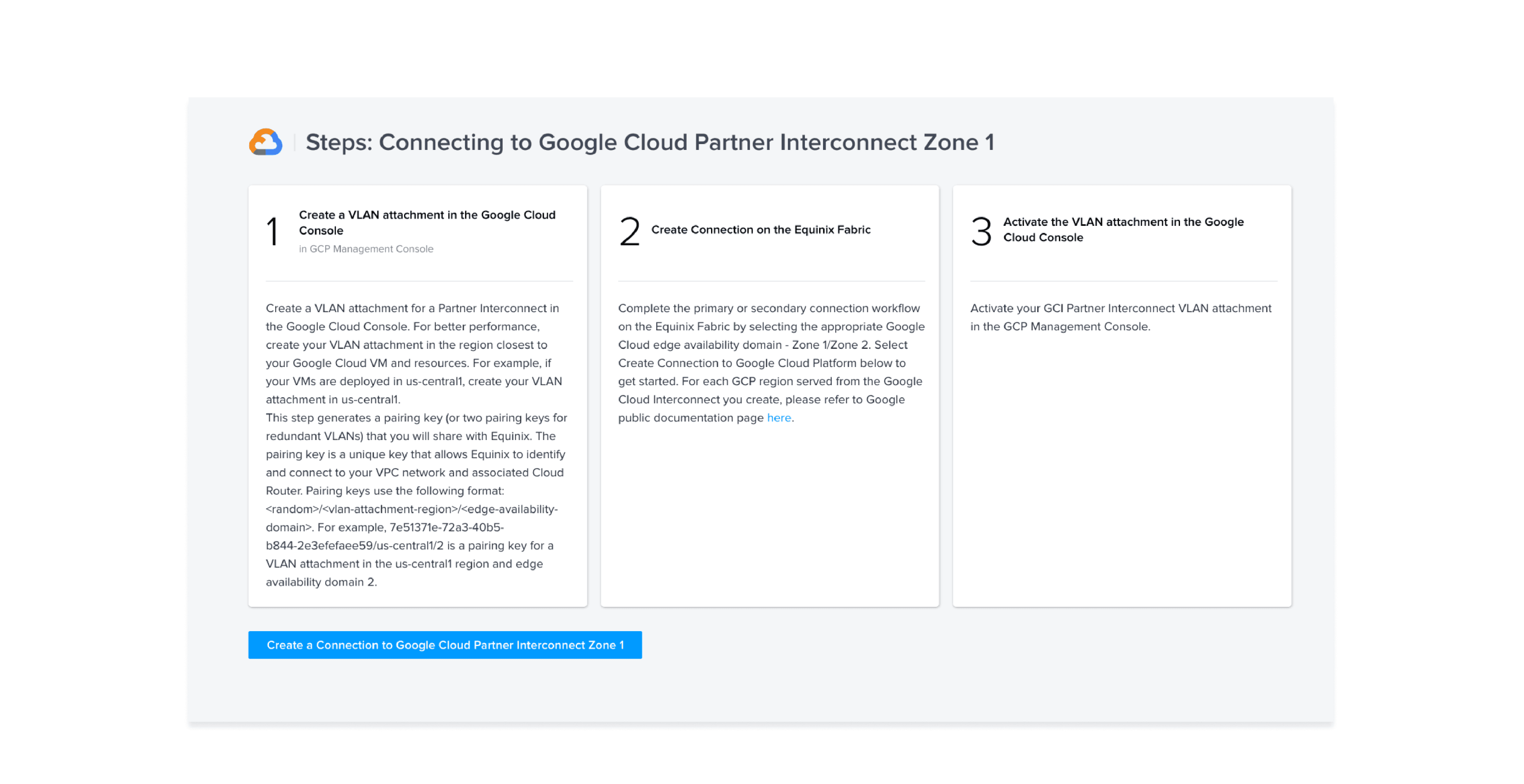
2. Single Connection Limitation: The system only supports creating one connection at a time. Establishing redundant connections doubles the effort and frustration due to the repeated multi-step process.
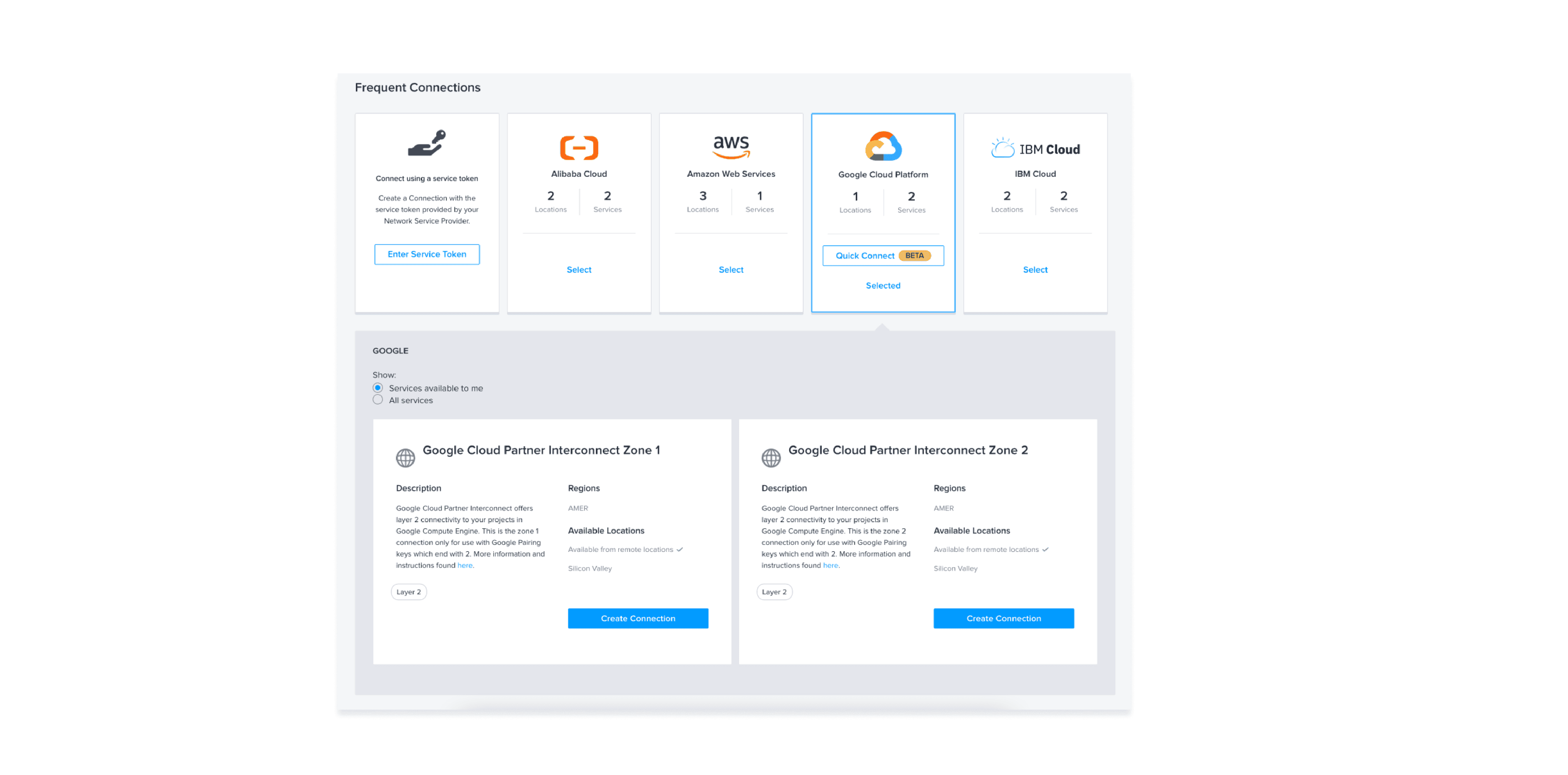
3. Activation Steps: After creating a connection, users must activate it via the Cloud Service Provider’s portal, adding unnecessary complexity.
4. Pricing and Location Clarity: The multipage form for connection setup hides pricing details until the final steps, requiring back-and-forth navigation to adjust pricing attributes. Additionally, the terminology used for locations is inconsistent with industry standards, leading to confusion.

goals and objectives
The objectives and goals for enhancing the QuickConnect feature aim to streamline and optimize the connection creation process:
1. Simplify the Connection Process: Eliminate the need for multiple portal visits by enabling all necessary connection steps within the Fabric portal.
2. Connection Activation: Integrate the ability to activate connections directly after linking, removing the need to visit the Cloud Service Provider’s portal.
3. Enhance Product Flexibility: Incorporate functionality to handle pre-existing keys and streamline the process for creating redundant connections for both primary and secondary links.
4. Analytics Implementation: Deploy analytics to gather comprehensive user and product metrics, which will inform future design and functionality improvements.
research observations
Interview with internal users Cloud Solution Architects, Global Support Team of Fabric - Create Virtual connection, disclosed below insights -
1. Multiportal fragmented process
2. Only single connection at a time
3. Lack of activation of connection
4. Lack of visibility to pricing quote
5. Naming of destination and device status unclear
competitive analysis
I did competitive analysis of existing tools which allow customers to create virtual connections to Cloud Service providers (AWS, Microsoft Azure, IBM Cloud and Stateless). Key points observed -
1. Guided Stepper
2. Long form for multiple connections
3. Lack of visibility of steps
4. Nested sub-steps

user flow synthesis of existing solution

design variations




design feedback

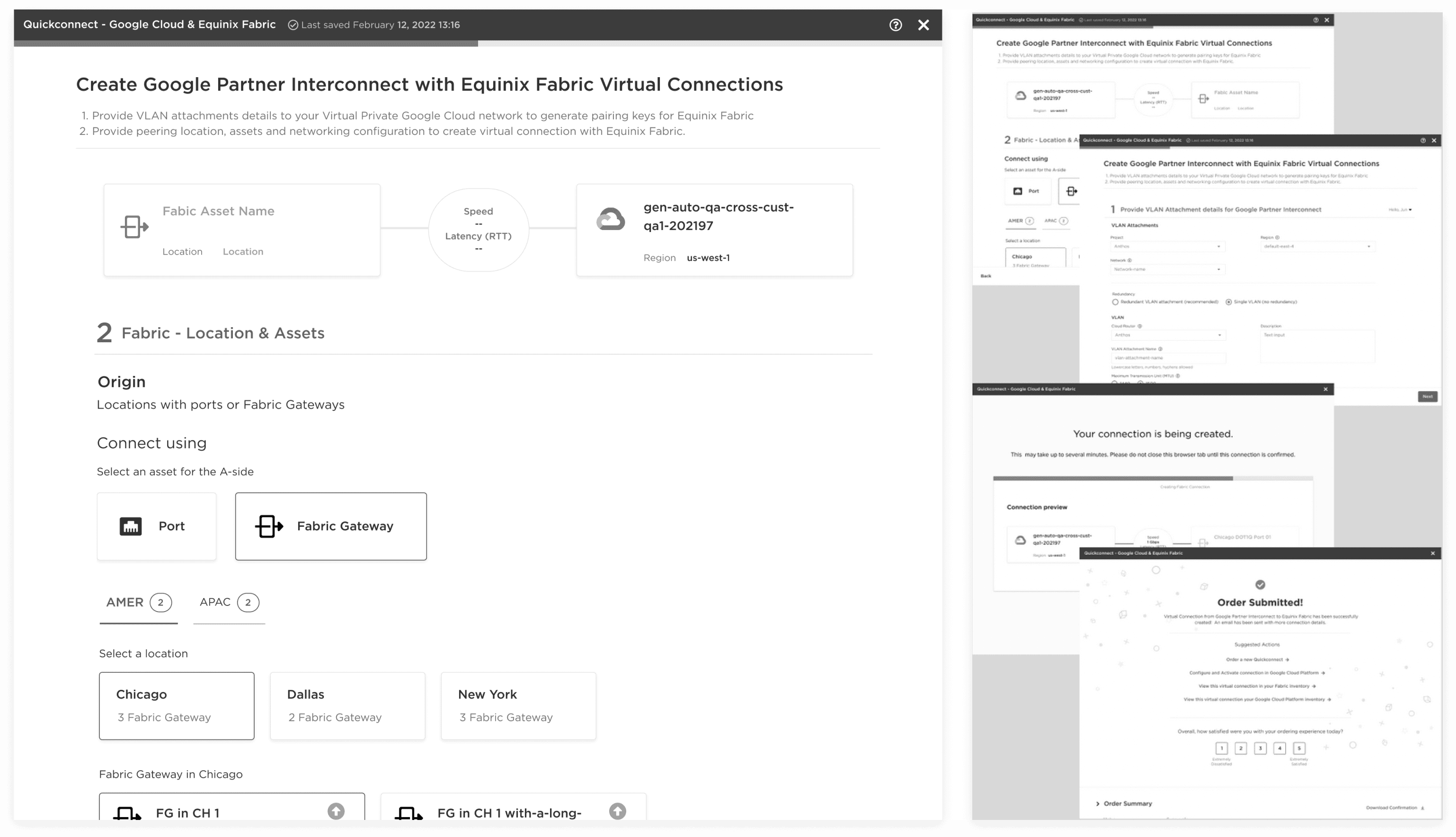
final solution

about the project
In the QuickConnect project at Fabric, my role as a UX designer was pivotal in transforming how Cloud Solution Architects interact with Cloud Service Providers like Google Cloud. I identified critical inefficiencies in the existing process for creating virtual connections, which was cumbersome and time-consuming, especially when establishing redundant connections. To address these challenges, I spearheaded user research, conducting interviews with internal architects to unearth pain points and synthesized these insights into user journey maps for three major Cloud service providers. My contributions included designing interactive Figma prototypes to visualize solutions, collaborating closely with Technical Product Managers and Architects to refine these designs, and implementing Analytics Metrics in Amplitude to monitor user interactions and inform future design enhancements. The culmination of this effort was the integration of a Cloud Service Providers Sign-in authentication step, enabling a more streamlined and automated connection process within the Fabric portal, significantly enhancing user experience and efficiency.
about the company
Equinix is the world’s most expansive, secure and sustainable data center platform which specializes in internet connection and digital interconnection related services. They own and operate a network of 220+ data centers in 44 major metropolitan areas and 22 countries on five continents.
problem identification
The current process for establishing connections with Cloud Service Providers is fraught with inefficiencies that compromise user experience. Key issues include:
1. Multiportal Process: Users must navigate between multiple portals, generating and using connection keys in a fragmented sequence that disrupts workflow.

2. Single Connection Limitation: The system only supports creating one connection at a time. Establishing redundant connections doubles the effort and frustration due to the repeated multi-step process.

3. Activation Steps: After creating a connection, users must activate it via the Cloud Service Provider’s portal, adding unnecessary complexity.
4. Pricing and Location Clarity: The multipage form for connection setup hides pricing details until the final steps, requiring back-and-forth navigation to adjust pricing attributes. Additionally, the terminology used for locations is inconsistent with industry standards, leading to confusion.

goals and objectives
The objectives and goals for enhancing the QuickConnect feature aim to streamline and optimize the connection creation process:
1. Simplify the Connection Process: Eliminate the need for multiple portal visits by enabling all necessary connection steps within the Fabric portal.
2. Connection Activation: Integrate the ability to activate connections directly after linking, removing the need to visit the Cloud Service Provider’s portal.
3. Enhance Product Flexibility: Incorporate functionality to handle pre-existing keys and streamline the process for creating redundant connections for both primary and secondary links.
4. Analytics Implementation: Deploy analytics to gather comprehensive user and product metrics, which will inform future design and functionality improvements.
research observations
Interview with internal users Cloud Solution Architects, Global Support Team of Fabric - Create Virtual connection, disclosed below insights -
1. Multiportal fragmented process
2. Only single connection at a time
3. Lack of activation of connection
4. Lack of visibility to pricing quote
5. Naming of destination and device status unclear
competitive analysis
I did competitive analysis of existing tools which allow customers to create virtual connections to Cloud Service providers (AWS, Microsoft Azure, IBM Cloud and Stateless). Key points observed -
1. Guided Stepper
2. Long form for multiple connections
3. Lack of visibility of steps
4. Nested sub-steps

user flow synthesis of existing solution

design variations




design feedback


final solution

about the project
In the QuickConnect project at Fabric, my role as a UX designer was pivotal in transforming how Cloud Solution Architects interact with Cloud Service Providers like Google Cloud. I identified critical inefficiencies in the existing process for creating virtual connections, which was cumbersome and time-consuming, especially when establishing redundant connections. To address these challenges, I spearheaded user research, conducting interviews with internal architects to unearth pain points and synthesized these insights into user journey maps for three major Cloud service providers. My contributions included designing interactive Figma prototypes to visualize solutions, collaborating closely with Technical Product Managers and Architects to refine these designs, and implementing Analytics Metrics in Amplitude to monitor user interactions and inform future design enhancements. The culmination of this effort was the integration of a Cloud Service Providers Sign-in authentication step, enabling a more streamlined and automated connection process within the Fabric portal, significantly enhancing user experience and efficiency.
about the company
Equinix is the world’s most expansive, secure and sustainable data center platform which specializes in internet connection and digital interconnection related services. They own and operate a network of 220+ data centers in 44 major metropolitan areas and 22 countries on five continents.
problem identification
The current process for establishing connections with Cloud Service Providers is fraught with inefficiencies that compromise user experience. Key issues include:
1. Multiportal Process: Users must navigate between multiple portals, generating and using connection keys in a fragmented sequence that disrupts workflow.

2. Single Connection Limitation: The system only supports creating one connection at a time. Establishing redundant connections doubles the effort and frustration due to the repeated multi-step process.

3. Activation Steps: After creating a connection, users must activate it via the Cloud Service Provider’s portal, adding unnecessary complexity.
4. Pricing and Location Clarity: The multipage form for connection setup hides pricing details until the final steps, requiring back-and-forth navigation to adjust pricing attributes. Additionally, the terminology used for locations is inconsistent with industry standards, leading to confusion.

goals and objectives
The objectives and goals for enhancing the QuickConnect feature aim to streamline and optimize the connection creation process:
1. Simplify the Connection Process: Eliminate the need for multiple portal visits by enabling all necessary connection steps within the Fabric portal.
2. Connection Activation: Integrate the ability to activate connections directly after linking, removing the need to visit the Cloud Service Provider’s portal.
3. Enhance Product Flexibility: Incorporate functionality to handle pre-existing keys and streamline the process for creating redundant connections for both primary and secondary links.
4. Analytics Implementation: Deploy analytics to gather comprehensive user and product metrics, which will inform future design and functionality improvements.
research observations
Interview with internal users Cloud Solution Architects, Global Support Team of Fabric - Create Virtual connection, disclosed below insights -
1. Multiportal fragmented process
2. Only single connection at a time
3. Lack of activation of connection
4. Lack of visibility to pricing quote
5. Naming of destination and device status unclear
competitive analysis
I did competitive analysis of existing tools which allow customers to create virtual connections to Cloud Service providers (AWS, Microsoft Azure, IBM Cloud and Stateless). Key points observed -
1. Guided Stepper
2. Long form for multiple connections
3. Lack of visibility of steps
4. Nested sub-steps

user flow synthesis of existing solution

design variations




design feedback


final solution

about the project
In the QuickConnect project at Fabric, my role as a UX designer was pivotal in transforming how Cloud Solution Architects interact with Cloud Service Providers like Google Cloud. I identified critical inefficiencies in the existing process for creating virtual connections, which was cumbersome and time-consuming, especially when establishing redundant connections. To address these challenges, I spearheaded user research, conducting interviews with internal architects to unearth pain points and synthesized these insights into user journey maps for three major Cloud service providers. My contributions included designing interactive Figma prototypes to visualize solutions, collaborating closely with Technical Product Managers and Architects to refine these designs, and implementing Analytics Metrics in Amplitude to monitor user interactions and inform future design enhancements. The culmination of this effort was the integration of a Cloud Service Providers Sign-in authentication step, enabling a more streamlined and automated connection process within the Fabric portal, significantly enhancing user experience and efficiency.
about the company
Equinix is the world’s most expansive, secure and sustainable data center platform which specializes in internet connection and digital interconnection related services. They own and operate a network of 220+ data centers in 44 major metropolitan areas and 22 countries on five continents.
problem identification
The current process for establishing connections with Cloud Service Providers is fraught with inefficiencies that compromise user experience. Key issues include:
1. Multiportal Process: Users must navigate between multiple portals, generating and using connection keys in a fragmented sequence that disrupts workflow.

2. Single Connection Limitation: The system only supports creating one connection at a time. Establishing redundant connections doubles the effort and frustration due to the repeated multi-step process.

3. Activation Steps: After creating a connection, users must activate it via the Cloud Service Provider’s portal, adding unnecessary complexity.
4. Pricing and Location Clarity: The multipage form for connection setup hides pricing details until the final steps, requiring back-and-forth navigation to adjust pricing attributes. Additionally, the terminology used for locations is inconsistent with industry standards, leading to confusion.

goals and objectives
The objectives and goals for enhancing the QuickConnect feature aim to streamline and optimize the connection creation process:
1. Simplify the Connection Process: Eliminate the need for multiple portal visits by enabling all necessary connection steps within the Fabric portal.
2. Connection Activation: Integrate the ability to activate connections directly after linking, removing the need to visit the Cloud Service Provider’s portal.
3. Enhance Product Flexibility: Incorporate functionality to handle pre-existing keys and streamline the process for creating redundant connections for both primary and secondary links.
4. Analytics Implementation: Deploy analytics to gather comprehensive user and product metrics, which will inform future design and functionality improvements.
research observations
Interview with internal users Cloud Solution Architects, Global Support Team of Fabric - Create Virtual connection, disclosed below insights -
1. Multiportal fragmented process
2. Only single connection at a time
3. Lack of activation of connection
4. Lack of visibility to pricing quote
5. Naming of destination and device status unclear
competitive analysis
I did competitive analysis of existing tools which allow customers to create virtual connections to Cloud Service providers (AWS, Microsoft Azure, IBM Cloud and Stateless). Key points observed -
1. Guided Stepper
2. Long form for multiple connections
3. Lack of visibility of steps
4. Nested sub-steps

user flow synthesis of existing solution

design variations




design feedback


final solution

01
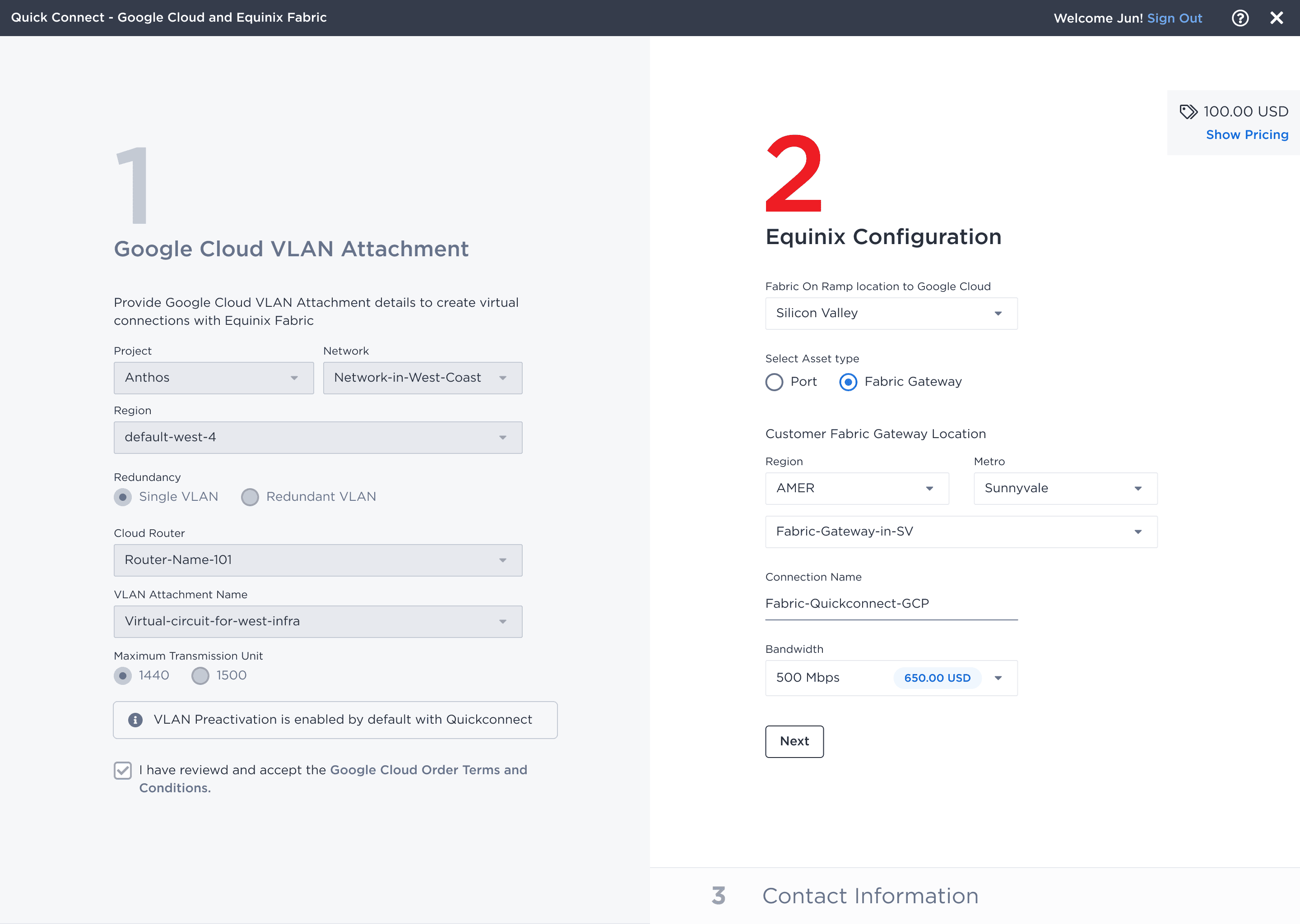
Quickconnect a new way to connect to Cloud service providers instantly and scale your digital infrastructure
01

Quickconnect a new way to connect to Cloud service providers instantly and scale your digital infrastructure
01

Quickconnect a new way to connect to Cloud service providers instantly and scale your digital infrastructure
01

Quickconnect a new way to connect to Cloud service providers instantly and scale your digital infrastructure
02
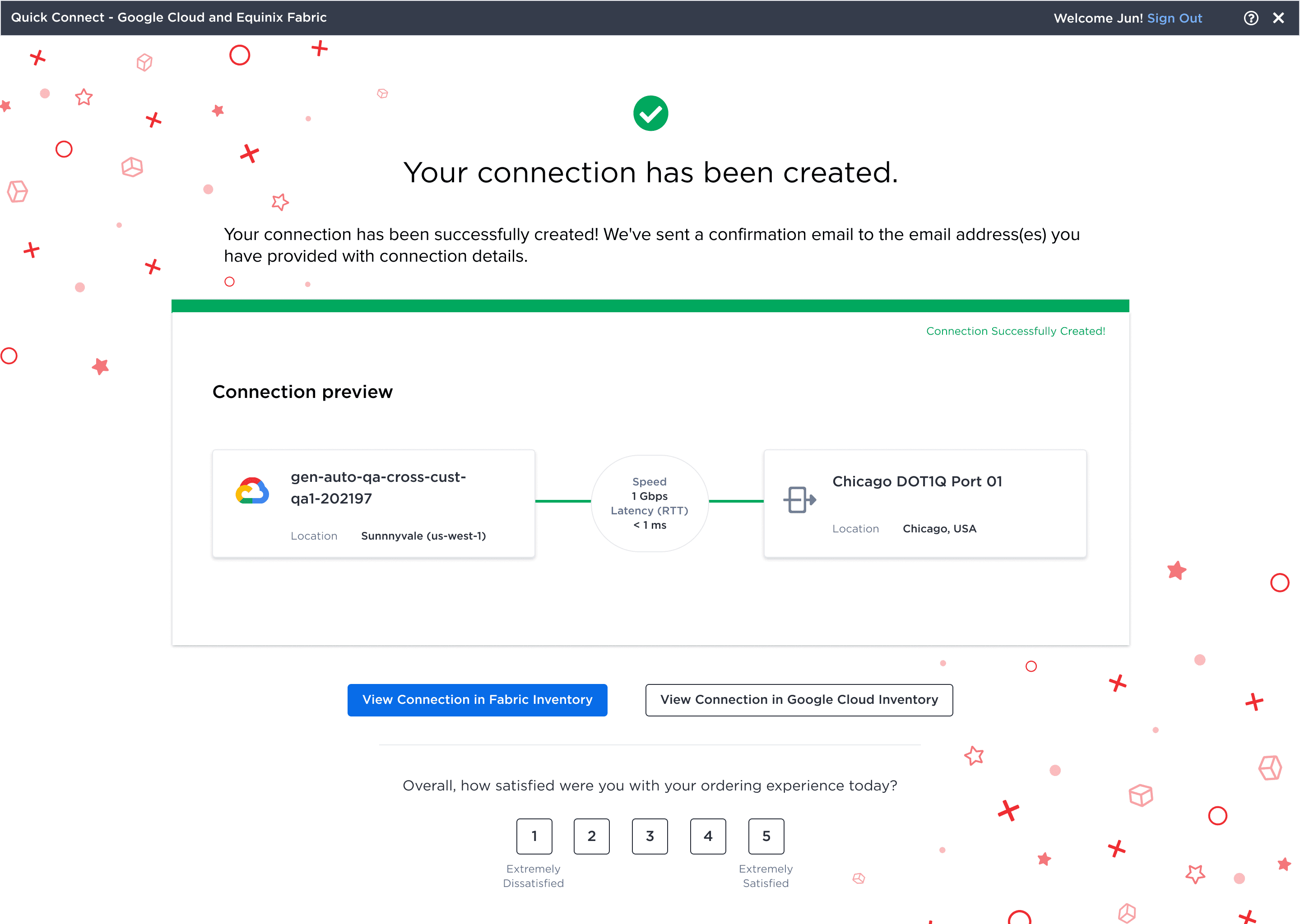
Instantly connect and activate your virtual connection to Cloud Service providers via Equinix Fabric
02

Instantly connect and activate your virtual connection to Cloud Service providers via Equinix Fabric
02

Instantly connect and activate your virtual connection to Cloud Service providers via Equinix Fabric
02

Instantly connect and activate your virtual connection to Cloud Service providers via Equinix Fabric
.say hello
i'm open for new job opportunities, feel free to email me to see how can we collaborate
.say hello
i'm open for new job opportunities, feel free to email me to see how can we collaborate
.say hello
i'm open for new job opportunities, feel free to email me to see how can we collaborate
.say hello

